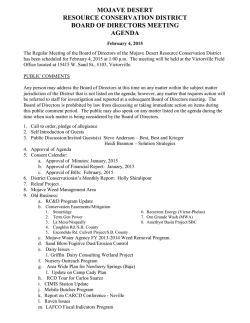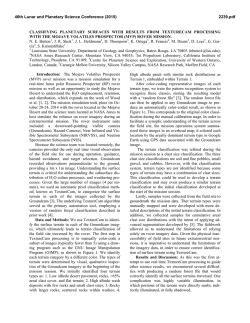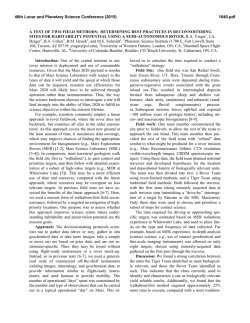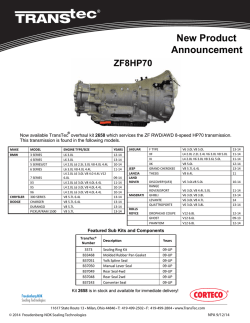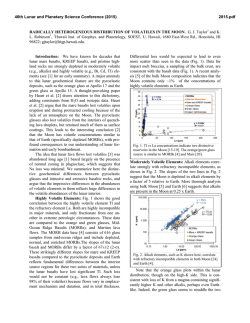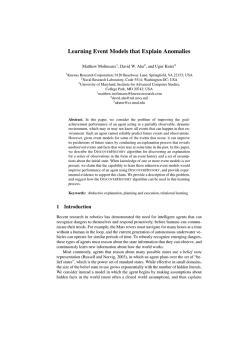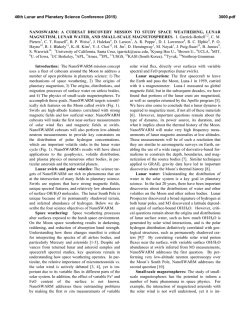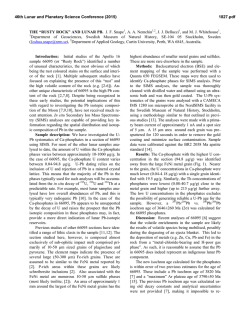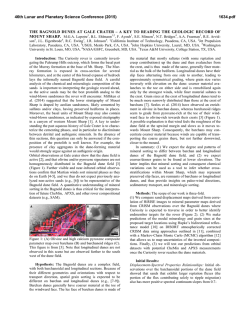
MOJAVE VOLATILES PROSPECTOR (MVP): SCIENCE AND
46th Lunar and Planetary Science Conference (2015) 2165.pdf MOJAVE VOLATILES PROSPECTOR (MVP): SCIENCE AND OPERATIONS RESULTS FROM A LUNAR POLAR ROVER ANALOG FIELD CAMPAIGN. J. L. Heldmann1, A. Colaprete1, A. Cook1, T. Roush1, M. Deans1, R. Elphic1, D. Lim1, J. R. Skok1, N. E. Button2, S. Karunatillake2, G. Garcia1 1NASA Ames Research Center, Moffett Field, CA 94035 ([email protected]), 2Louisiana State University, Geology and Geophysics Department, Baton Rouge, LA 70803 Introduction: The Mojave Volatiles Prospector (MVP) project is a science-driven field program with the goal of producing critical knowledge for conducting robotic exploration of the Moon. MVP feeds science, payload, and operational lessons learned to the development of a real-time, short-duration lunar polar volatiles prospecting mission. MVP achieved these goals through a simulated lunar rover mission to investigate the composition and distribution of surface and subsurface volatiles in a natural and a priori unknown environment within the Mojave Desert, improving our understanding of how to find, characterize, and access volatiles on the Moon. Mission Overview: The prime objectives of MVP were to 1) mature instruments (Near Infrared and Visible Spectrometer Subsystem (NIRVSS) and Neutron Spectrometer Subsystem (NSS)) prospecting operations concept through integration and robotic field testing in native soils in a lunar analog setting, 2) improve and mature xGDS real-time science tools through analog science operations in a natural setting where the abundance and distribution of water is not known a priori, and 3) conduct a scientific investigation of water content in the Mojave Desert by mapping native water distribution and variability in abundances similar to lunar polar volatiles as a realistic analog to mapping at the lunar poles. The MVP field site was the Mojave Desert, selected for its low, naturally occurring water abundance. The Mojave typically has on the order of 2-6% water, making it a suitable lunar analog for this field test. MVP used the NIRVSS and NSS plus a downward facing GroundCam camera on the KREX-2 rover (Figure 1) to investigate the relationship between the distribution of volatiles and soil crust variation. Through this investigation, we matured robotic in situ instruments and concepts of instrument operations, improved ground software tools for real time science, and carried out publishable research on the water cycle and its connection to geomorphology and mineralogy in desert environments. Operations: A lunar polar rover mission is unlike prior space missions and requires a new concept of operations. The lunar rover must navigate 3-5 km of terrain and examine multiple sites in a just a few days. Operational decisions must be made in real time, requiring constant situational awareness, data analysis and rapid turnaround decision support tools. MVP conducted a simulated lunar polar rover mission with the NASA KREX-2 rover (Figure 1) operated in the Mojave Desert by a remote Science Operations Center located at NASA Ames Research Center and a Rover Operations Center located in the Mojave, with each location staffed with specific console positions (Figure 2). A Science Backroom was also located at Ames where scientists typically conducted more in-depth data analysis during the mission. MVP used the Exploration Ground Data Systems (xGDS) software to develop strategic and tactical mission plans, monitor rover data in real-time, and conduct science data analysis. Operations Results. MVP demonstrated that realtime rover operations is a new concept of operations for planetary missions. Initial findings are listed below for the topics of console architecture, xGDS, communications, and decision making. Console architecture: Science interests must be adequately represented within the Operations Center, and the use of a Science Backroom is beneficial for performing more detailed data analysis and/or targeted tasks. However, the Backroom typically lacks adequate situational awareness to significantly participate in real-time operational decisions. Figure 1. K-REX2 rover used for MVP field campaign. Figure 2. Science (top) and Rover (bottom) Operations Centers for MVP. 46th Lunar and Planetary Science Conference (2015) xGDS: Real-time rover data monitoring by the Science Team to inform real-time decision making requires specialized ground data systems, and the capabilities of xGDS were critical for enabling this mission architecture. The Science Team needs a real-time ability to respond to science data (e.g., update traverse plans, modify rover activities, etc.), and archived rover data is necessary for Science follow-up to test hypotheses, revisit sites, and inform operations. Communications: Communications protocols within the operations architecture are required to facilitate real-time decision making. Also, Science must be in direct communication with rover navigation and rover driver teams to enable efficient real-time operations. Decision making: Flexibility must remain within the daily operations plans to react to unexpected/interesting data and/or situations as warranted. Science must also have operational decision making authority. A priori criteria should be established to guide real-time operations, but Science also must have authority to deviate from nominal plan based on situational awareness and experience gained during the mission. Science. The science goal of MVP was to understand the water emplacement, distribution, and retention within the Mojave Desert. Previous work [1, 2] has suggested that the Mojave subsurface water distribution is related to the surface clast cover. For MVP we therefore mapped out the various surface types (considering rock size distribution and coverage) based on the rover imagery, and analyzed the NIRVSS and NSS prospecting data to determine native water abundances. We also collected surface and subsurface samples from each terrain type for additional laboratory analysis. In addition, we conducted a water drop experiment where a known volume of water was systematically introduced over a 1 m2 patch of ground within each terrain type. Rover data and samples were collected prior to the water drop and for several days thereafter to obtain a time profile of water migration. Four distinct terrain types were identified from the MVP data. Terrain 1 is a low albedo desert pavement with small rocks and <65% clast cover. Terrain 2 is a high albedo wash terrain with few rocks and small pebble sizes. Terrain 3 is a wash deposit with scattered rock / cobble cover and Terrain 4 is similar to Terrain 1 but with higher albedo. To determine native water content, returned samples were baked at 100C for 114 hours to release any unbound water. Each terrain type had a native water abundance of 2-3 weight % water. Initial XRD analysis indicates that soil composition includes primarily quartz, albite (sodium plagioclase feldspar), and illite (phyllosilicate). 2165.pdf Visible-near infrared lab spectra are shown in Figure 3. The baseline data are for native Mojave soil while the “T+0.3 hr” data are for soils 0.3 hours after the water drop experiment. In these data, the 1900 nm band deepens, indicating the presence of more water, as expected. We have quantitatively analyzed the 1900 nm band depth for the water drop samples over each terrain as a function of time. We find that 1) the band depth systematically increases post-water drop, 2) the largest band depth increases are seen in upper 1-10 cm in the subsurface, 3) band depths decrease as the soil dries over 28 hours (drying curve) 4) band depths are lowest (and relatively constant) after soils were baked > 24 hrs, indicating water has been released, and 5) there are negligible changes in band depths at soil depths of 10-20 cm. Figure 3. VIS-NIR spectra of Mojave soils. “Baseline” indicates native Mojave samples and “T+0.3hr” indicates data collected from samples 0.3 hours post-water drop. Based on these datasets, we suggest that the Mojave soil water abundances are comparable to the expected abundances of lunar south pole cold traps (~2-3 wt %). Water in the Mojave does not penetrate beneath the upper ~10 cm of water (based on the band depths data and the measured water weight percentages) as infiltration is prevented via absorption by the soil materials. This interpretation is supported by the initial XRD analysis suggesting the presence of clays, which are efficient at absorbing water. Samples from 10-20 cm depths generally have lower native water abundances than 1-10 cm depths and do not show increases in water abundance with water drop experiment. In addition, Terrain 3 had the largest change in band depth after the water drop experiment, suggesting the rocky wash terrains have highest water retention potential. References: [1] Wood, Y. A. et al. (2002) J. Arid Enviro., 52, 305-317. [2] Wood, Y. A. et al. (2005) Catena, 59, 205-230. Acknowledgments: The authors would like to thank the MVP Science, Operations, and Assessment teams. Special thanks to Janice Bishop and Adrian Brown (SETI Institute) for use of the SETI Soils Lab & UV-VIS ASD Spectrometer. We also appreciate the support of David Blake and Tom Bristow (NASA Ames) for use of the XRD instrument.
© Copyright 2026
